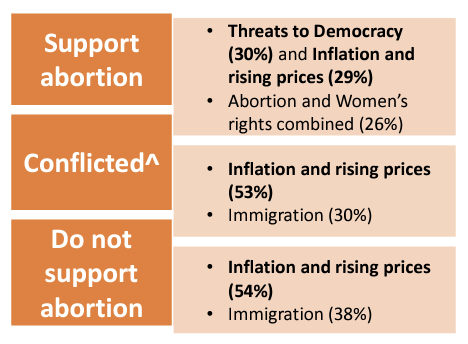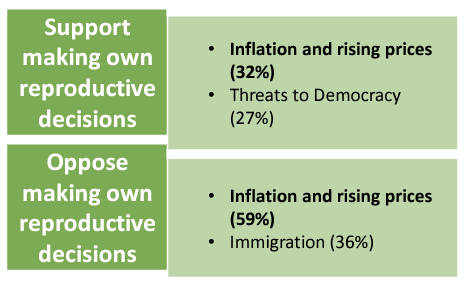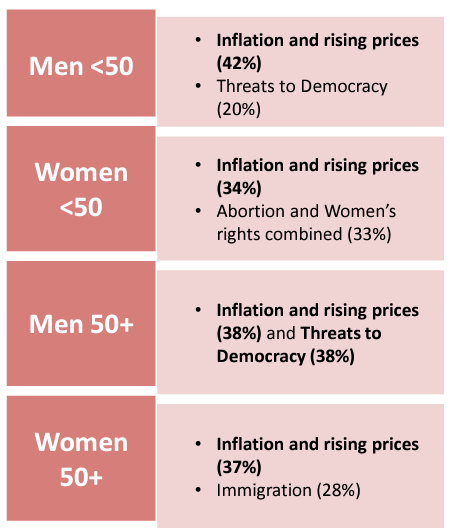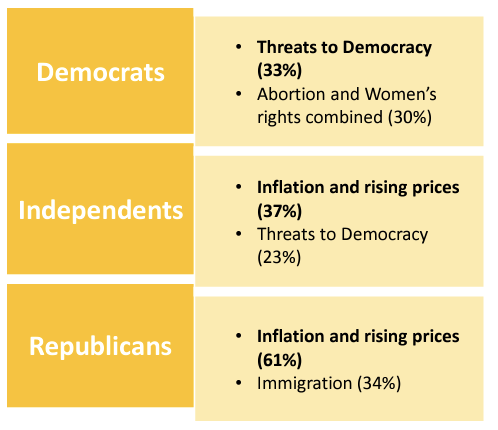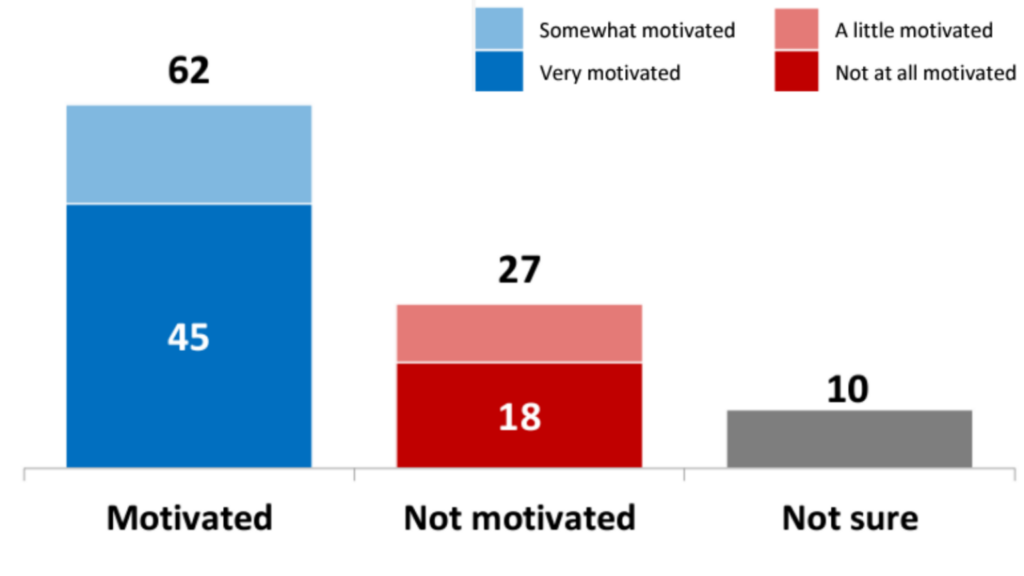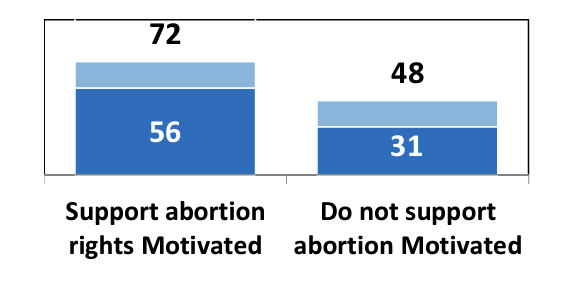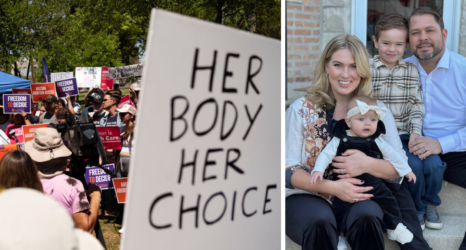
Abortion and the Equal Rights Amendment are strong voter turnout issues separately, but even more powerful when combined, according to a new national poll by Lake Research Partners for Ms. and the Feminist Majority Foundation (FMF), publisher of Ms.
In particular, candidates talking about abortion and the ERA together is a powerful combination to mobilize Democrats and Independents (especially Independent women), younger women, voters who support abortion rights, college-educated women, Latinas and Black voters, and voters ages 30-39.
Almost three-quarters (74 percent) of all voters support a person’s right to make their own reproductive decisions without government interference, including about abortion, contraception and continuing a pregnancy, the poll also found. Only 17 percent were opposed.
Notably, half of Republicans and 81 percent of Independents said they support an individual’s right to make their own reproductive decisions. There is a gender gap among Independents and Republicans, with women more likely to strongly support a person’s right to make their own reproductive decisions.
Among voters who support abortion rights, especially younger women, abortion and women’s rights combined are top issues that will determine their vote next year.
Banning abortion also motivates voters to turn out in the 2024 elections, with 72 percent of voters who support abortion rights motivated, compared to 48 percent of voters who do not support abortion rights.
“The overturning of Roe v. Wade has lit a fire under voters, and continues to be a powerful turnout issue, especially among younger women, college-educated women, Latinas and voters ages 30-39,” said Kathy Spillar, executive editor of Ms. magazine, at a press conference at the National Press Club in D.C.
In the poll, voters overwhelmingly expressed support for the Equal Rights Amendment: Seven in 10 voters support the ERA being placed in the Constitution, with a strong majority (57 percent) strongly supporting the ERA, compared to 12 percent who oppose the ERA.
“Now that voters, especially women voters, know that rights can be taken away, they want an amendment to the U.S. Constitution guaranteeing that rights cannot be ‘denied or abridged on account of sex,’” said Eleanor Smeal, president of FMF and long-time ERA leader.
Support for the ERA is a universal value among Democrats and very strong with Independents, especially Independent women.
All demographic subgroups, except for Republicans, said they strongly supported placing the ERA in the Constitution. However, among Republican women, 50 percent support adding the ERA to the Constitution.
A majority of voters also said they consider themselves to be a feminist or a strong feminist (59 percent), according to the poll, compared to 29 percent who said they are not a feminist or anti-feminist. Those with the largest margin who said they are a feminist, compared to those who said they are not, include younger women, college-educated women, Democrats and Independent women. In all cases, there is a gender gap in every subgroup, with women more likely to consider themselves to be a feminist than men.
“For voters who support abortion rights, younger women and Democrats, abortion and women’s rights combined are top issues that will determine their vote next year,” said Celinda Lake, president of Lake Research Partners. “Talking about abortion and the ERA together is very powerful. There are a lot of younger women voters … lagging in registration. This is a combination that can get them turned out to vote.”
A full analysis of the survey is as follows:
+ For all voters, inflation and rising prices is the top of mind issue. Four in 10 said it is the most important issue that will determine their vote in elections next year. Following inflation and rising prices is threats to democracy. Abortion and women’s rights combined is a top issue.
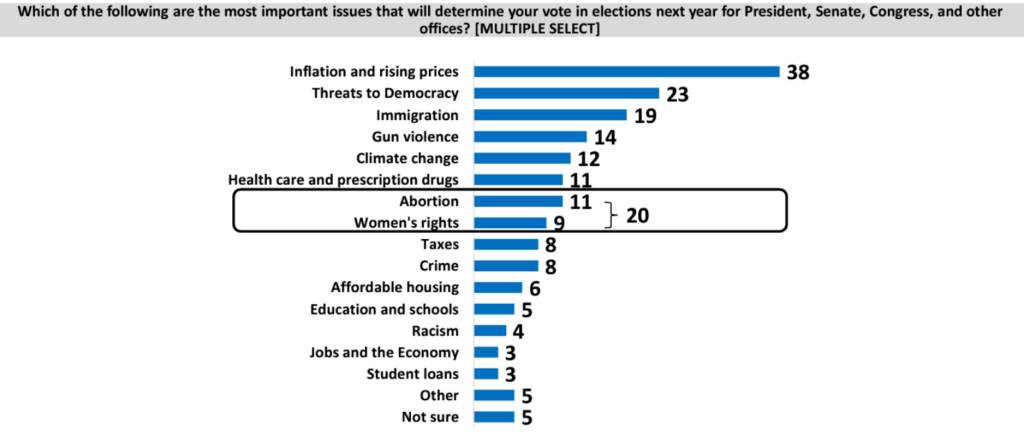
+ Across demographic subgroups, except for Democrats, inflation and rising prices is the top issue. For voters who support abortion rights, younger women and Democrats, abortion and women’s rights combined are top issues that will determine their vote next year.
+ A majority of voters said they consider themselves to be a feminist or a strong feminist.
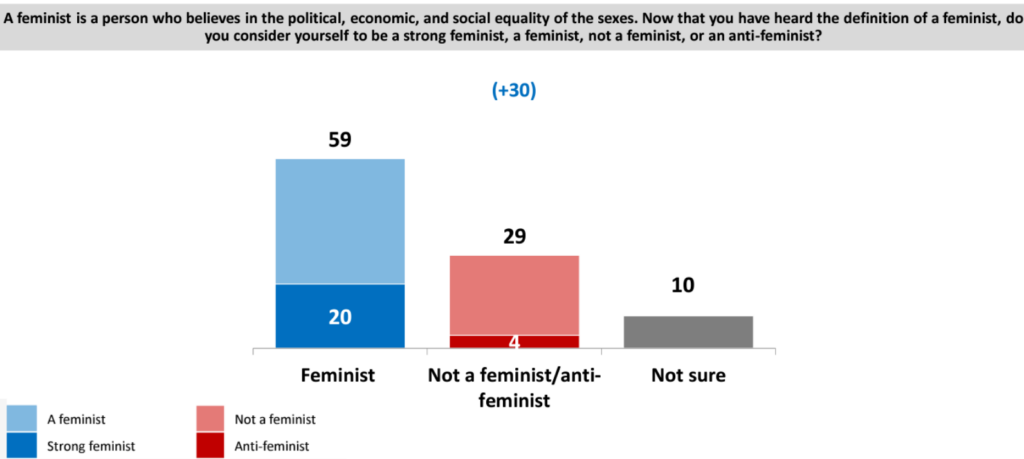
+ Across demographic subgroups, except for non-college-educated men and Republicans, at least half of voters consider themselves to be a feminist. Those with the largest margin of those who said they are a feminist compared to those who said they are not, include younger women, college-educated women, Democrats, and Independent women. There is a gender gap as subgroups of women are more likely to consider themselves to be a feminist than subgroups of men.
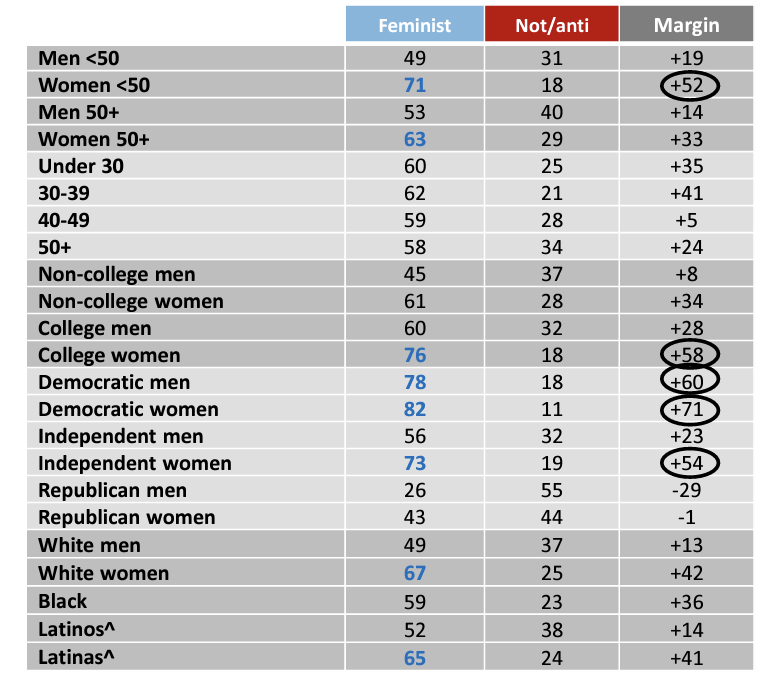
+ A majority of registered voters support abortion rights. Over four in 10 said they believe abortions should be legal and generally available.
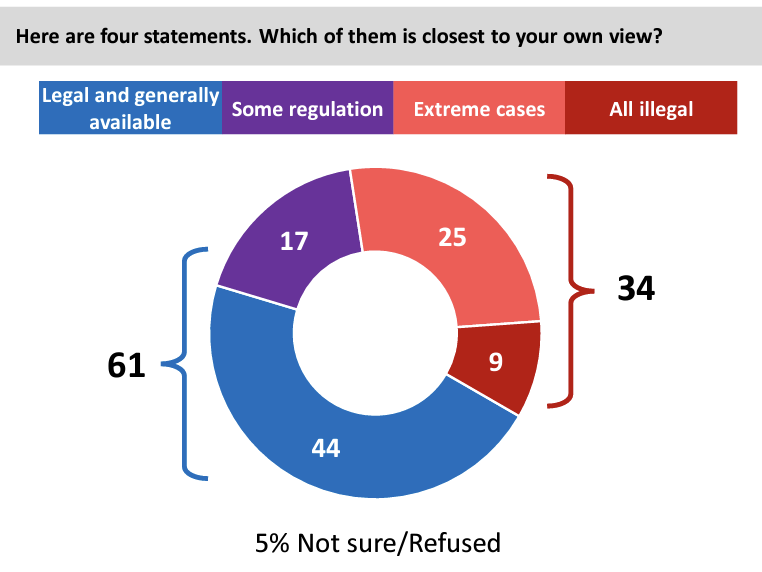
+ Across subgroups, except for Republicans, a strong majority of voters support abortion rights. Latinas, Black voters, younger women, Democrats, college-educated voters and Independent women are most likely to believe abortions should be legal and generally available.
Republican men and women solidly do not support abortion rights.
“We’re talking about the future, and we know that Latina women are going to be influential in the coming election,” said Dolores Huerta, labor rights leader and Feminist Majority Board member, at the D.C. press conference. She concluded: “Yes we can—si se puede.”
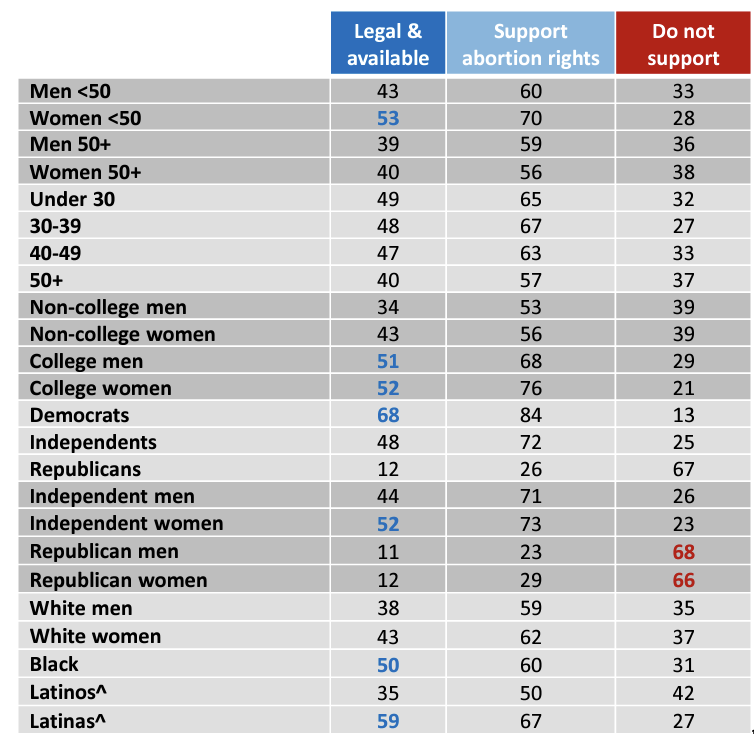
+ Across gender, age, education, party identification and race, voters support a person’s right to make their own reproductive decisions. Notably, half of Republicans support this. Black voters, Democrats and Independents, younger women, college-educated women, Latinas and voters ages 30-39 are most likely to strongly support a person’s right to make their own reproductive decisions.
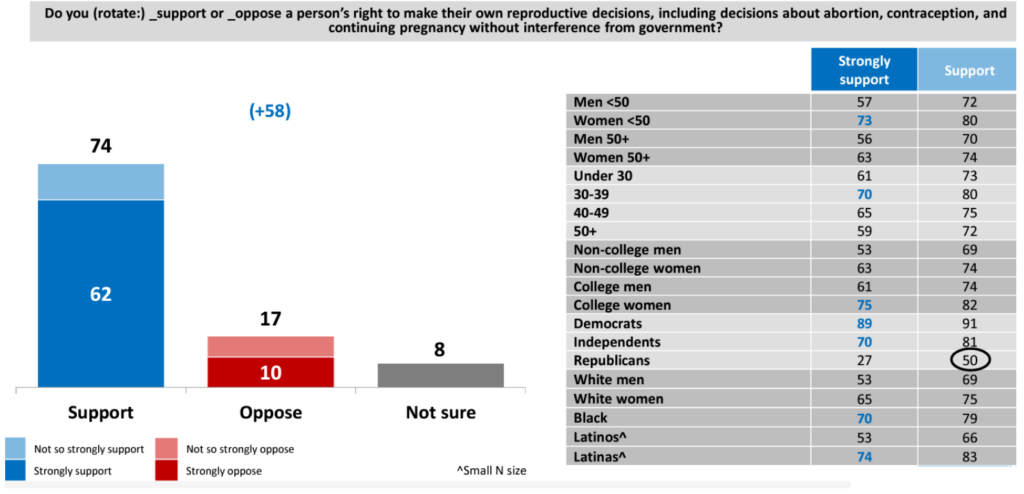
+ There is a gender gap among Independents and Republicans: Independent women and Republican women are more likely to strongly support a person’s right to make their own reproductive decisions than their male counterparts.
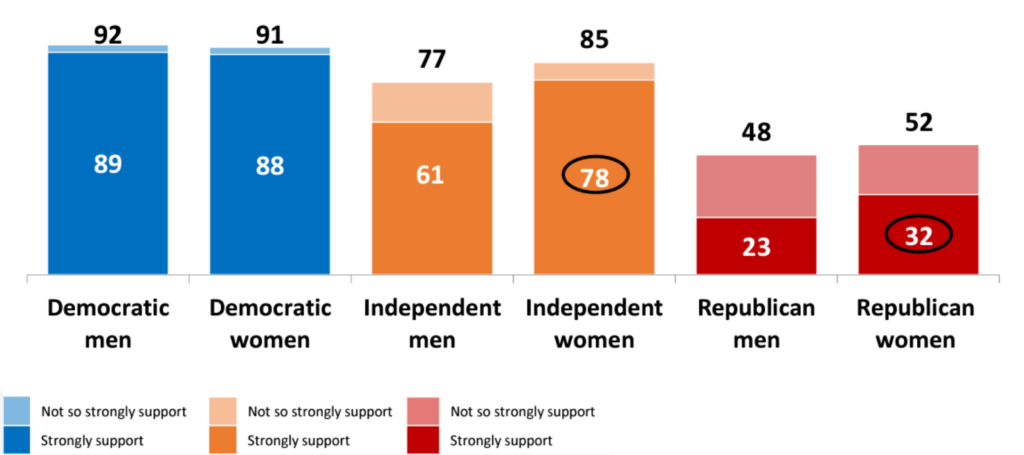
+ Banning abortion motivates voters to vote in the elections next year. Only about a quarter are not motivated by banning abortion, and one in 10 are not sure. Notably, voters who support abortion rights are much more energized by this issue than voters who do not support abortion rights.
+ Banning abortion makes younger women, voters ages 30 to 39, college-educated women, Latinas and Democrats the most intensely motivated to vote next year.

+ Among party identification, women are more motivated to vote by banning abortion than men are. Independent women are especially more intensely motivated to vote next year than their male counterparts, with a 16-point difference in intense motivation and 20 points overall.
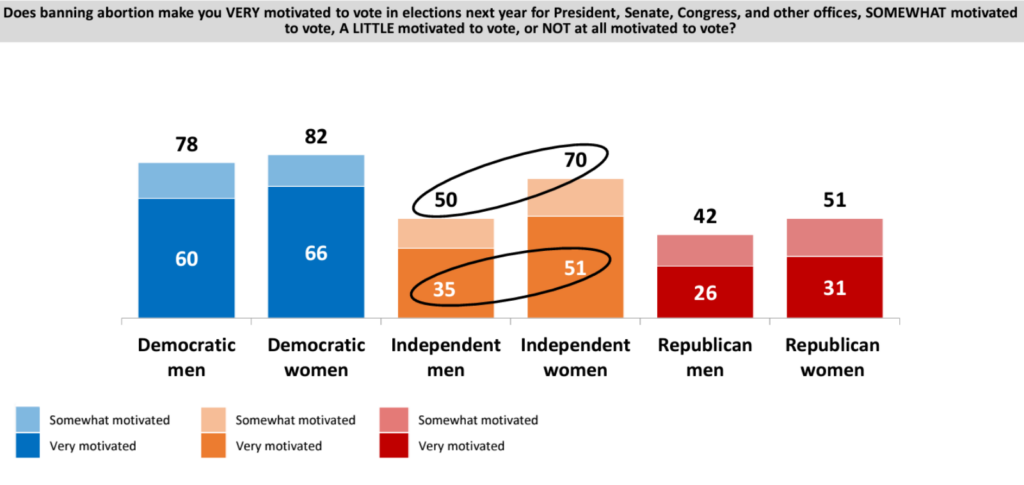
+ Seven in 10 voters support the Equal Rights Amendment being placed in the Constitution, and a strong majority strongly support this. There are more who are not sure than there are opposed.
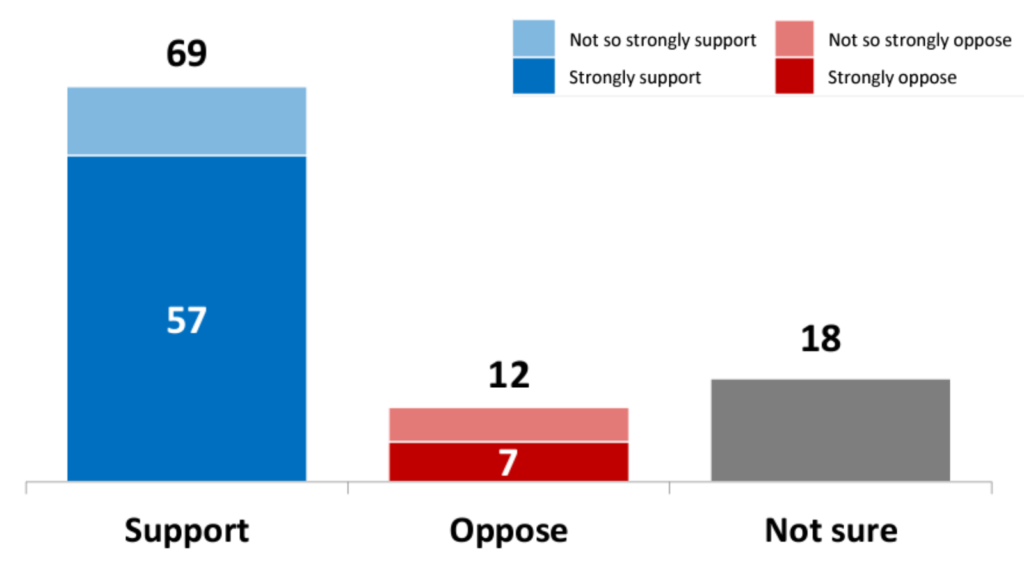
+ At least half of voters across demographic subgroups, except for Republicans, strongly support placing the ERA in the Constitution. Six in 10 or more women, voters ages 40 to 49, college-educated women, Democrats and Independents, and Black voters, white women, and Latinas strongly support this. A plurality of Republicans support the ERA.
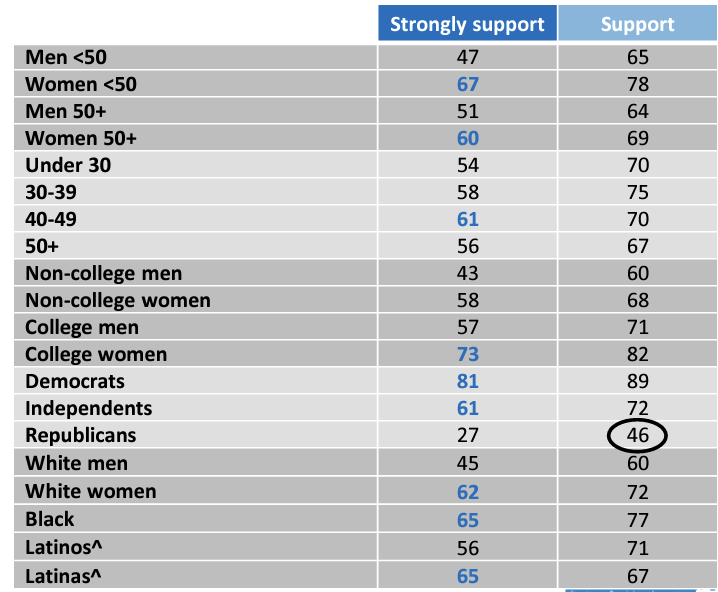
+ There is a gender gap among Independents and Republicans, where the women are much more likely to strongly support the ERA than the men, especially Independent women who are 23 points more likely than Independent men to strongly support the ERA. Democrats solidly support it no matter their gender.
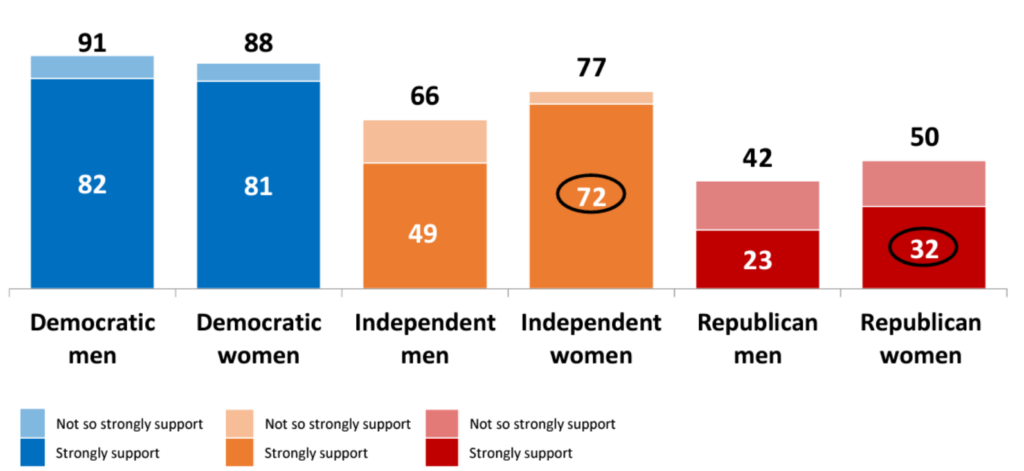
Linking Abortion and the ERA
The ERA could provide a new basis for challenging state-level bans on access to abortion and other reproductive health services—a strategy currently being tested in Utah. Abortion bans exacerbate sex inequalities in educational, economic and political life caused by childbearing and childrearing.
In 1998, the New Mexico Supreme Court ruled that an abortion funding prohibition violated New Mexico’s Equal Rights Amendment. In a similar 1986 case, a Connecticut court struck down a law that only allowed Medicaid funding for abortion when a pregnancy endangers a woman’s life. The court ruled that choosing to fund all medically necessary procedures except for abortion is sex discrimination in violation of Connecticut’s Equal Rights Amendment.
Earlier this week with @MsMagazine reviewing findings of @Lake_Research what's motivating women to vote, its impact on the upcoming elections as well as to celebrate the 50th anniversary of Ms. Recent poll by LPR @celindalake shows that 7 out of 10 voters support the ERA. #ERANow pic.twitter.com/Qsw0Pwt482
— Zakiya Thomas ☂️ (@ZakiyaEra) September 29, 2023
ERA advocates have laid out a strategy for final recognition of the ERA:
- a joint congressional resolution to remove the timeline and recognize the ratification of the ERA: House Joint Resolution 25 was introduced by Rep. Ayanna Pressley (D-Mass.) and Senate Joint Resolution 4 by Sen. Ben Cardin (D-Md.) in the House and Senate, respectively. “Constitutional law scholars carefully crafted this resolution’s language, modeled on the congressional resolution recognizing the 14th Amendment, in order to prevail in any future legal challenges to the ERA,” reported Carrie Baker in Ms.
- a separate congressional resolution, called the “ERA Now” resolution, instructing the archivist to publish the ERA as the 28th Amendment: Rep. Cori Bush (D-Mo.), co-chair of the Congressional Caucus for the Equal Rights Amendment, and Sen. Kirsten Gillibrand (D-N.Y.) introduced the legislation. (The resolution is meant to work in concert with the one above.)
- a “discharge petition,” which seeks to compel the House of Representatives to vote on H.J. Res. 25 to remove the arbitrary deadline for ratification: Under House rules, if a discharge petition to compel a vote on a particular piece of legislation is signed by 218 members of the House, it must immediately be brought before the full chamber for a vote, regardless of any objections or attempts to block the legislation from being considered. Now that Pressley has filed it, the petition will remain open until it garners the necessary 218 signatures necessary to be called for a vote.
- a petition drive to show widespread support for the amendment: Public support for the ERA is around 85 percent. (Sign the petition here.)
As for abortion rights, the Women’s Health Protection Act (WHPA) is proposed federal legislation that would codify Roe v. Wade into law and establish the legal right to abortion in all 50 states.
WHPA has been reintroduced in several congressional sessions—but last year, the bill saw the highest numbers of original co-sponsors ever. The U.S. House has voted to pass WHPA twice: in September 2021 and July 2022. But in the Senate, WHPA failed to secure the 60-vote threshold needed to make it to the floor for a vote, after all Senate Republicans, joined by Democratic Sen. Joe Manchin (W.Va.), prevented cloture, which would have forced a vote.
50 Years of Ms.
Ms. has been reporting consistently on abortion rights and the ERA since its founding 50 years ago. A new book from Ms. out last month, 50 Years of Ms.: The Best of the Pathfinding Magazine That Ignited a Revolution is a collection of some of the best feminist classics from the last five decades—including the revolutionary “We Have Had Abortions” petition (one year before the Roe v. Wade ruling); “Abortion Is Essential to Democracy,” a multimedia project connecting the fight for abortion rights and the fight for representative democracy, created in collaboration with the Brennan Center; and “We Want In,” celebrating the modern push for the ERA.
Methodology
Lake Research Partners designed this survey that was fielded in an omnibus survey conducted online from Sept. 8-10, 2023. The survey reached a total of 1,000 adults and this data includes only the 847 registered voters who were surveyed.
The survey was fielded online using a probability sample. Households invited to join the panel are randomly selected from all available households in the U.S. Persons in the sampled households are invited to join and participate in the panel. The demographic benchmarks of the total adults surveyed came from the 2022 March Supplement of the Current Population Survey (CPS). The data for registered voters were weighted to adjust for gender by region, age, race, gender by race, and gender by choice stance to reflect the demographic composition of the registered voter population.
The margin of error is +/-3.4 percent. The margin of error for subgroups is higher.
Up next:
U.S. democracy is at a dangerous inflection point—from the demise of abortion rights, to a lack of pay equity and parental leave, to skyrocketing maternal mortality, and attacks on trans health. Left unchecked, these crises will lead to wider gaps in political participation and representation. For 50 years, Ms. has been forging feminist journalism—reporting, rebelling and truth-telling from the front-lines, championing the Equal Rights Amendment, and centering the stories of those most impacted. With all that’s at stake for equality, we are redoubling our commitment for the next 50 years. In turn, we need your help, Support Ms. today with a donation—any amount that is meaningful to you. For as little as $5 each month, you’ll receive the print magazine along with our e-newsletters, action alerts, and invitations to Ms. Studios events and podcasts. We are grateful for your loyalty and ferocity.



